HGTV Couldn’t Cover It All

Sebring’s history is so rich and layered, our spotlight on HGTV’s Home Town Takeover could not even begin to scratch the surface of the full story. From Sebring’s storied history in car racing, the orange industry, land conservation, unique architecture; there is so much more to Sebring, Florida!
Let us teach you 10 more facts about the unique history of Sebring; from our beginnings in the 1900’s to now!
1. Founded in a Circle by George Sebring
 George E. Sebring, a pottery mogul and entrepreneur from Ohio, designed the town on a circular plan inspired by the ancient Egyptian city of Heliopolis according to archival records; though some believe he had other inspirations too.
George E. Sebring, a pottery mogul and entrepreneur from Ohio, designed the town on a circular plan inspired by the ancient Egyptian city of Heliopolis according to archival records; though some believe he had other inspirations too.
We are one of the oldest surviving “circle” cities. Downtown Sebring’s hub, now “Circle Park”, radiates outwards with six avenues, earning us the nickname “City on the Circle”. Sebring’s original idea was that all roads would lead to the circle, and while a lot has changed in our city, this essential design element remains true for our downtown historic district.
The city was founded as a winter resort town, and became deeply rooted in citrus and cattle industries; industries you can still see represented in our area to this day.
2. Racing Roots - From Airbase to 12 Hours
 Sebring is home to one of the oldest continuously running race tracks in the United States. Our first race was held on New Years Eve in 1950- just four years after the Hendricks Army Airfield was decommissioned after the end of World War 2.
Sebring is home to one of the oldest continuously running race tracks in the United States. Our first race was held on New Years Eve in 1950- just four years after the Hendricks Army Airfield was decommissioned after the end of World War 2.
Our first 6‑hour race, the Sam Collier 6 Hour Memorial race, evolved into the legendary 12 Hours of Sebring endurance race commencing in March 1952. Another fun fact about the Sebring International Raceway is that part of the racetrack was also simultaneously an airport runway for the Sebring Regional Airport, utilizing the old runway from Hendricks Army Airfield.
Fans from all around the country and world flock to Sebring each year for many races, but most notably for IMSA’s 12 Hours of Sebring endurance race each March. The racing culture in Sebring runs deep, with some fans who have been camping out and partying at the races for over 50 years. Planning a trip in 2026? Mark your calendars for March 18-21, 2026 and be sure to check out our best hotels to book for your stay in advance!
3. Lake Wales Ridge - Ancient Land We Call Home
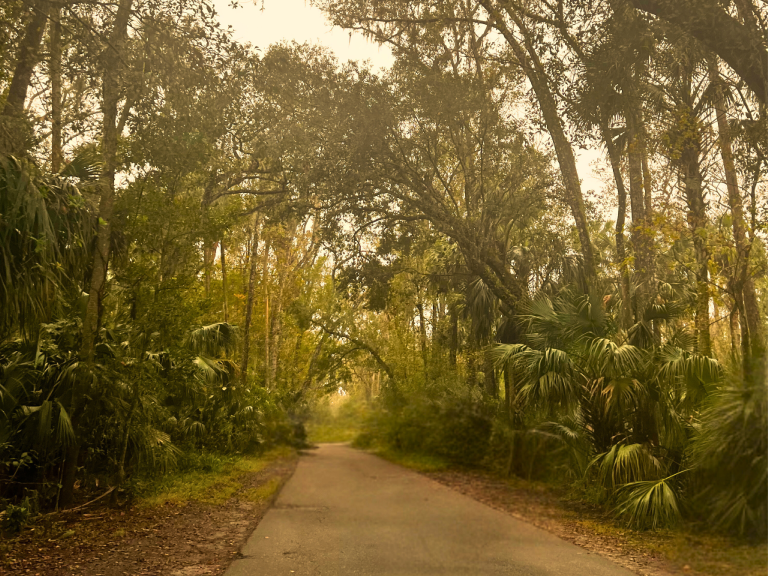
Sebring sits atop the Lake Wales Ridge, a 100-mile ancient sand ridge that was once a chain of islands two million years ago. At one time, the Ridge was completely isolated as the sea levels were higher, and it allowed our indigenous species to evolve uniquely in the scrub ecosystem. We are positioned on the oldest and highest ridge in Florida.
We have multiple protected lands and parks for visitors to experience the ancient scrub ecosystem right here in Highlands County. If you’re in Sebring for a few days, check out the Highlands Hammock State Park, Archbold Biological Station, and the Lake Wales Ridge Wildlife and Environmental Area.
Bird watchers can keep an eye out for the illusive and rare scrub jay, or catch some sandhill cranes taking a stroll by the lake. Biologists can search for unique moss and lichen on ancient trees that will be here long after we are gone. Our home is home to unique flora and fauna that biology enthusiasts won’t be able to find anywhere else!
4. Highlands Hammock- Florida’s Ancient Forest
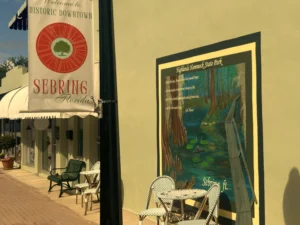 While wandering in downtown Sebring, you may see one of our HGTV Home Town Takeover murals of the historic Highlands Hammock State Park, and feel inspired to visit!
While wandering in downtown Sebring, you may see one of our HGTV Home Town Takeover murals of the historic Highlands Hammock State Park, and feel inspired to visit!
Less than 15 minutes from Downtown Sebring lies Highlands Hammock State Park, one of the oldest parks in Florida. The park was founded in 1931 after years of private and public interest in preserving the land for residents and winter visitors. Highlands Hammock was officially opened as Florida’s FIRST state park in August of 1935, and is one of the original Civilian Conservation Corps (CCC) parks in Florida.
Visit the Civilian Conservation Corps museum at at the Hammock to learn more about Roosevelt’s New Deal and conservation efforts that made way for our beautiful state park to be protected land. From there, you can discover Highlands Hammock State Park by finding one of the easily marked trails, including the boardwalk trail, or by taking a guided tram tour of the park. Enjoy your day at the park walking trails that showcase cypress swamps, hammocks, and scrub ecosystems that mirror our region’s primordial landscape.
5. Art Deco Influences in Downtown
 When visiting downtown Sebring, you’ll see that there are a lot of incredible examples of 1920’s architecture and design. We have a couple of places that you can catch some Art Deco inspiration around downtown, so be sure to keep an eye out for these buildings!
When visiting downtown Sebring, you’ll see that there are a lot of incredible examples of 1920’s architecture and design. We have a couple of places that you can catch some Art Deco inspiration around downtown, so be sure to keep an eye out for these buildings!
The historic Circle Theatre was one of the buildings renovated by HGTV Home Town Takeover. Step inside the theatre to be brought back to the 1920’s splendor of art deco, and get a taste of Hollywood magic right here in Sebring.
Another more hidden gem of downtown Sebring is our fire station at 301 N Mango Street- which was built in 1927. You can see the tower from multiple angles on the circle, but it’s best to get a look of the structure up close. Central Station was added to the US National Register of Historic Places in 1989
6. Early Citrus Industry
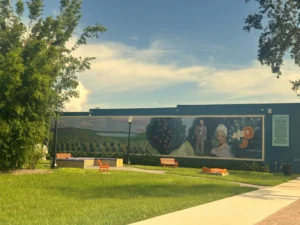 Before Sebring became known worldwide for racing and our charming historic architecture, it was citrus that shaped us! The sandy soils, low freeze risk and overall subtropical climate of the Lake Wales Ridge made the Sebring area ideal for growing citrus. By the early 20th century, citrus groves stretched across Highlands County. Thanks to the groves, we needed a train, as well as big beautiful buildings for those travelling to Sebring!
Before Sebring became known worldwide for racing and our charming historic architecture, it was citrus that shaped us! The sandy soils, low freeze risk and overall subtropical climate of the Lake Wales Ridge made the Sebring area ideal for growing citrus. By the early 20th century, citrus groves stretched across Highlands County. Thanks to the groves, we needed a train, as well as big beautiful buildings for those travelling to Sebring!
Early visionaries left impacts on Sebring’s commercial development and our citrus legacy that can still be seen to this day. One of these families were the Kahns; Lithuanian Jewish immigrants who arrived to Sebring in the 1920s. Knowing just a little English on arrival, and seeking opportunity, George Sebring welcomed them to the young city.
Michael and Sadie Kahn originally opened a dry goods store on the historic Circle downtown, in what used to be the Nan-Ces-O-Wee building. The entrepreneurs expanded into citrus by the 1930’s, then real estate, and multi-generational civic leadership. You can see a tribute to the influential Kahn family on North Ridgewood Ave. at Sadie Kahn Park, where the Nan-Ces-O-Wee used to stand.
7. The Salvation Army Building
George Sebring was an avid supporter of the Salvation Army, and donated land in the early days of our city to the organization. For years, the building was used to host church services, until 2019 when the church disbanded.
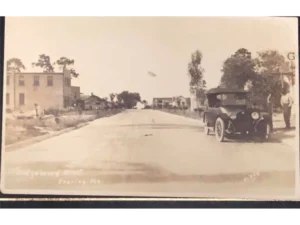 The front stained glass window, depicting the founder of the organization, was a N Ridgewood Ave. hidden gem. The stained glass was removed to be placed in the Salvation Army Atlanta Archives for preservation.
The front stained glass window, depicting the founder of the organization, was a N Ridgewood Ave. hidden gem. The stained glass was removed to be placed in the Salvation Army Atlanta Archives for preservation.
The building is now known for it’s renovation by HGTV’s Ben and Erin Napier on Home Town Takeover. Sophie’s Cafe is a tourist favorite, and a great place to get pictures to memorialize your visit to Sebring!
8. The Roanoke- Downtown Sebring’s Historic Hotel

Nestled at 209-213 Circle Drive, right in the heart of Historic Downtown Sebring, the Roanoke Hotel has a long history. The hotel has recently been restored to reflect the era in which it was built. The Sebring Development Company built the iconic downtown hotel in 1917, and the building is now recognized as a contributing property within the Sebring Downtown Historic District, listed on the National Register of Historic Places.
As one of the earliest buildings to pop up on Circle Park, the Roanoke has stood tall for over a century of life and change in our community. Built before hotels like The Kenilworth and Harder Hall, the hotel supported early citrus-era commerce and cattle trade visitors. Vintage film footage from the 1920s even captures residents walking past the Roanoke, a vivid reminder of its longstanding presence at the center of downtown Sebring. Guests are invited to sip morning coffee on the private balcony overlooking the iconic Sebring Circle, where the view connects you directly to the legacy of our extraordinary city.
Thanks to modern revitalization efforts– it’s almost as if the walls of the Roanoke could talk! Following years of careful preservation, the Roanoke Hotel has been meticulously restored to reflect its original 20th‑century sophistication while offering modern amenities. Take your pick of ten uniquely themed guest rooms, each outfitted with artisan furnishings that honor Sebring’s roots!
9. Museums and History for all Interests!
Sebring and our surrounding towns in Highlands County have a rich history for you to engage in. What better way to experience history than walking through our downtown district or checking out our local museums?
 Are you interested in military history? You can visit the Medal of Honor Memorial on S Commerce Ave, or learn from exhibits about the Navy, the Marines & the Coast Guard at the Military Sea Services Museum off of Kenilworth near downtown.
Are you interested in military history? You can visit the Medal of Honor Memorial on S Commerce Ave, or learn from exhibits about the Navy, the Marines & the Coast Guard at the Military Sea Services Museum off of Kenilworth near downtown.
Or maybe you are more of an art type- check out the Highlands Art League off of Lakeview Drive, SFSC Museum of Florida Art and Culture in Avon Park, or the Highlands Cultural Alliance’s Peter Powell Roberts Museum of Art.
Bringing the kiddos? Be sure to check out the Children’s Museum of the Highlands for some quality imagination time!
Some other history buff options include the Avon Park Depot Museum, the State of Florida Civilian Conservation Corps Museum at Highlands Hammock State Park, and the Charles F. Weigle House.
10. The Rex Beach House and Tragedy
Rex Ellingwood Beach (1877–1949) was a bestselling adventure novelist and Olympic water polo medalist who settled permanently in our hometown of Sebring during the 1920s. 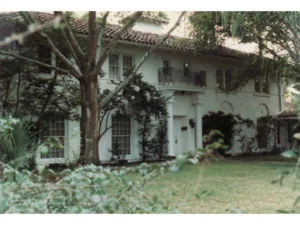 After living at the glamorous Harder Hall resort, he purchased a lakeside home in Sebring in 1929. Though his literary output slowed upon moving to Sebring, Beach’s presence enriched our cultural identity; his 1935 novel Wild Pastures was set in the cattle country surrounding Sebring.
After living at the glamorous Harder Hall resort, he purchased a lakeside home in Sebring in 1929. Though his literary output slowed upon moving to Sebring, Beach’s presence enriched our cultural identity; his 1935 novel Wild Pastures was set in the cattle country surrounding Sebring.
Sadly, after the death of his wife Edith (Greta) in 1947, the onset of throat cancer and blindness, Beach’s physical decline deepened. On December 7, 1949, in his Sebring residence, he took his own life.
His home has since become part of local lore because during a 2005 renovation a bullet was discovered lodged in the wall, believed to be the same that ended his life. Today, the former Beach residence remains a haunting but cherished part of Sebring’s history, reminding locals and tourists alike of a talented author and complex character who made our lakeside town his final home.

